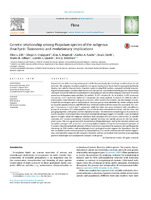Genetic relationship among paspalum species of the subgenus anachyris : taxonomic and evolutionary implications
Date
2014-10-01Author
Zilli, Alex Leonel
Hojsgaard, Diego Hernán
Brugnoli, Elsa Andrea
Acuña, Carlos Alberto
Honfi, Ana Isabel
Urbani, Mario Hugo
Quarin, Camilo Luis
Martínez, Eric Javier
Metadata
Show full item recordAbstract
Paspalum is one of the most important genera of the Poaceae family due to its large number of species anddiversity. The subgenus Anachyris comprises six species mainly from South America grouped together bysharing rare spikelet characteristics. A genetic analysis using ISSR markers, compared with the morpho-logical and phenotypic variation observed in each one species, was used to establish genetic relationshipsamong 40 accessions with several ploidy levels, belonging to 5 species of the subgenus Anachyris. Fourteen accessions of Paspalum malacophyllum (2x and 4x), 12 of P. simplex (2x, 3x, 4x and 6x), 4 of P. procurrens(2x and 4x), 4 of P. usterii (4x) and 6 of P. volcanensis (4x) were analysed. A total of 227 ISSR loci (98.7%polymorphic) were detected among all accessions, with variable loci number and percentages of poly-morphism according to species delimitations. Six main groups were identified by cluster analysis basedon Jaccard?s genetic distance and UPGMA, four of which matched all the respective accessions of P. sim-plex, P. procurrens, P. usterii and P. volcanensis, while the other two were consistent with two differentgroups of accessions of P. malacophyllum, one involving most tetraploid accessions, and the other onegrouping together a tetraploid and two diploid accessions. The distinctive morphological characteristicsand the separate clustering of these tetraploid and diploid cytotypes suggest to consider a new multiploidspecies complex inside the subgenus Anachyris. Both cytotypes of P. procurrens, and the four co-specificcytotypes of P. simplex consistently clustered together forming two specific groups for the two multi-ploid taxons. This is in agreement with the existence of high phenotypic similarities between diploid andtetraploid cytotypes of P. procurrens, and among diploid, triploid, tetraploid and hexaploid cytotypes of P. simplex. Since the polyploid cytotypes of these species are reproduced by apomixis, the specific genetic clustering by ISSR markers and morphological and cytological results support the hypothesis that thetwo multiploid species were originated by autopolyploidy. Our results confirm previous studies suggest-ing a monophyletic origin for the subgenus Anachyris and are concordant with previous data regardinggenomic homologies and phylogenetic analyses in the genus.
Collections
The following license files are associated with this item:




